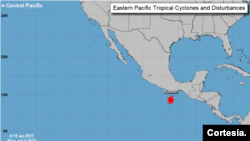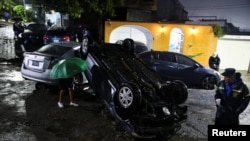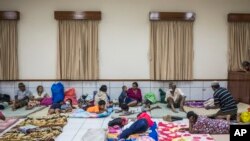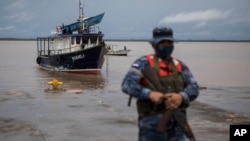Bonnie became a hurricane on Sunday and advanced this Monday along the Mexican Pacific coast, after crossing Central America causing heavy rains in southern Mexico, floods that left one dead in El Salvador and the evacuation of thousands of people in Nicaragua and Costa Rica. .
Meteorologists predict that the hurricane, that moves heading west-northwest across the Pacific at a speed of 18 miles per hour, stay out to sea. But the National Hurricane Center of the United States (NHC for its acronym in English) warned that it could cause heavy rains during the next few days in some regions of Guatemala and southwestern Mexico.
Bonnie had maximum sustained winds of 80 miles per hour Monday morning, according to the NHC.
Mexico’s National Meteorological Service said in a statement on Sunday that the storm would cause heavy rains in the southeast and southwest of the territory, with waves of 2 to 4 meters high on the coasts of the states of Oaxaca and Chiapas.
The Mexican authorities urged the population of Oaxaca, Chiapas and Veracruz to take extreme precautions, and warned that the rainfall could generate landslides, an increase in the levels of rivers and streams, and overflows and floods in low-lying areas, mainly in those three states.
Bonnie is one of the rare storms to cross from the Atlantic to the Pacific without losing its tropical storm strength, thus keeping its name.
Bonnie left one dead in El Salvador, which will continue to be affected by heavy rains
The intense rains that occurred on Saturday in much of El Salvador caused the death of a woman, flooding in different parts of the country and heavy flooding in streets and highways.
The Civil Protection authorities of the Central American country reported that a 24-year-old woman died in a populous community in the Municipality of San Martín, east of the capital.
The authorities have declared a yellow alert in 12 municipalities of the Salvadoran coastal zone.
The NHC warned that southern El Salvador will continue to be affected by heavy downpours.
Floods in Nicaragua
In Nicaragua, the passage of the storm caused the overflow of rivers and floods in the rural municipalities of Waslala, Mulukukú and Siuna (north Caribbean), as well as in Nueva Guinera (in the south), and in El Rama, El Tortuguero, Prinzapolka and Oxen Dock (South Caribbean).
Residents and local leaders reported numerous flooded neighborhoods in the town of El Rama, a river port 290 kilometers (180 miles) southeast of Managua, after the river of the same name rose several meters and municipal authorities recommended the evacuation of inhabitants. of the highest risk areas.
“The Kukarawala River is also overflowing and efforts have been made all night to get people out of that area,” said Jenny Rivas, representative of the opposition Liberal Party in El Tortuguero. “The El Salto bridge, which connects El Rama with El Tortuguero, was destroyed and (the latter municipality) was cut off,” she added.
For its part, the Municipality of Muelle de los Bueyes published on its Facebook page that it had mobilized technical brigades and heavy machinery to areas affected by landslides that blocked a section of the highway between El Rama and Managua.
The authorities of the National Disaster Prevention System (Sinapred) have not offered new reports on the situation in the affected areas. Unofficially, people were reported dead after being swept away by currents, but the government has not yet confirmed this information.
The government declared on Saturday that the operation against the storm had been “a complete success” and that on Monday it will present an official balance.
With information from The Associated Press
Connect with the Voice of America! Subscribe to our channel Youtube and turn on notifications, or follow us on social media: Facebook, Twitter and Instagram.













![National Library, a millionaire work of 54 million dollars donated by China, located in the Historic Center of San Salvador, El Salvador. [Fotografía Karla Arévalo / VOA]](https://thelatestnews.world/wp-content/uploads/2025/03/Life-after-the-eviction-of-informal-vendors-in-the-center.jpg)

Add Comment